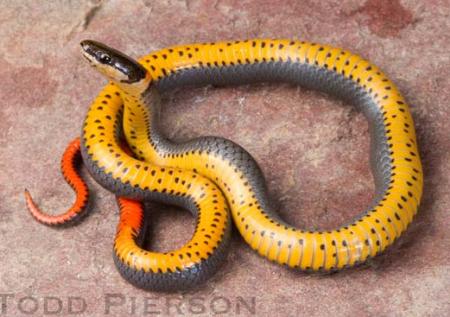Ring-necked Snake (Diadophis punctatus)

Click a thumbnail below to view the larger image:




Have you seen a Ring-necked Snake?
Click the Report Snake button below to reporting seeing a Ring-necked Snake.
Report Snake SightingAppearance
Ring-necked Snakes are slender, smooth-scaled snakes. Their back color can range from olive, greenish-gray, blue-black, to black. Their bellies are yellow, orange or red. Occasionally small black spots are present on their bellies. A light colored ring is found around the neck. Ring-necked snakes have a divided anal plate.
Size
Adult snakes can range between 10 – 18 inches in total length.
Habitat/Range
Ring-necked Snakes can be found throughout Kentucky. They are often found under rocks and logs in forested areas.
Natural History
These snakes are secretive and primarily nocturnal. Prey include earthworms, slugs, snails, small salamanders and frogs, and occasionally small lizards. Birds, other snake species, and some amphibians (i.e., bullfrogs) are known to consume Ring-necked snakes. Reproduction occurs in spring and fall, and 2-7 eggs are laid during summer months.
Notes/Miscellaneous
Although harmless to humans, Ring-necked Snakes have enlarged, posterior teeth and mildly toxic saliva, which may be used to paralyze prey. Ring-necked Snakes release a pungent musk as a defensive behavior. They have also been observed to flash their bright colored bellies, which may confuse or startle predators.
